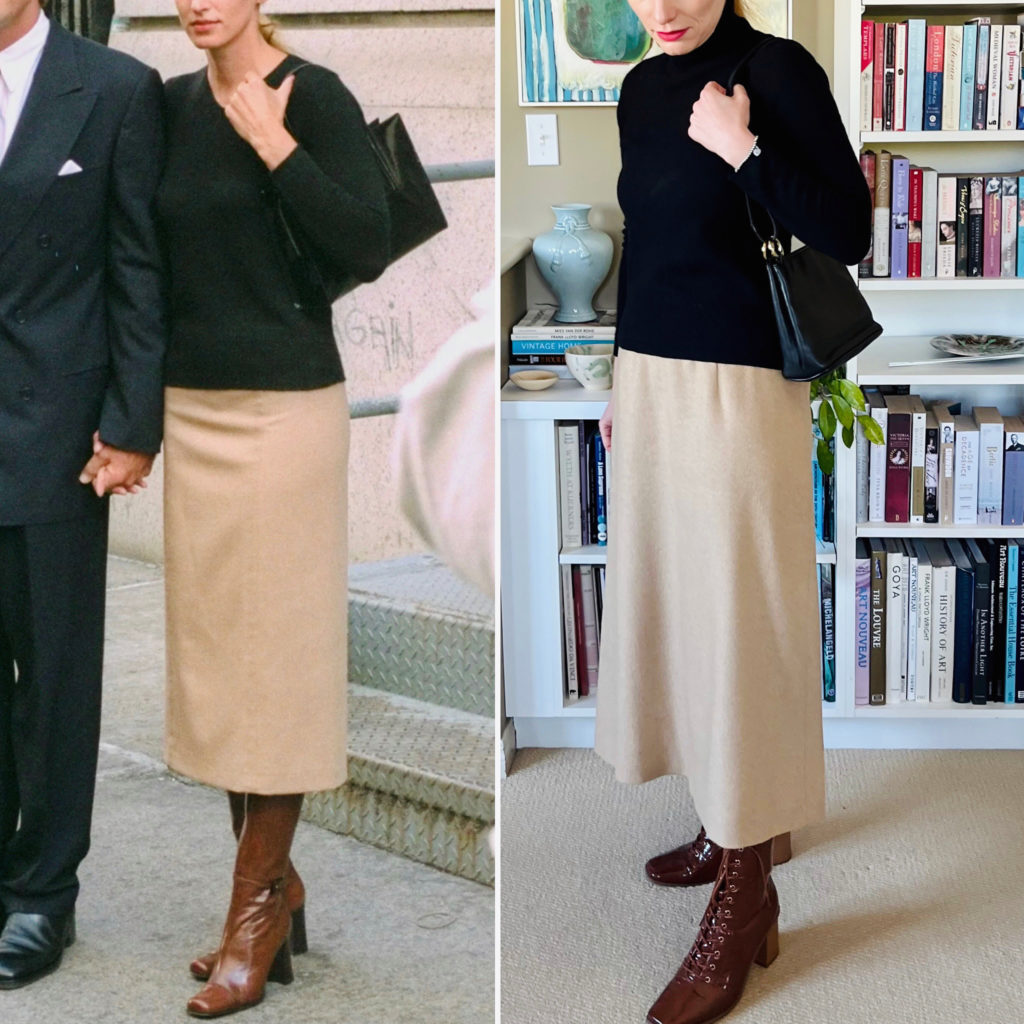If, like me, you are a Gen X / Xennial who grew up on a steady diet of Vogue and Vanity Fair, there is probably a not-insignificant folder in your mental Rolodex devoted to all things Carolyn Bessette Kennedy. There was a period of time, in the mid-to-late 90s, when CBK was the epitome of cool. But not, and I cannot emphasize this enough, Gone Girl’s Cool Girl:
“Men always say that as the defining compliment, don’t they? She’s a cool girl. Being the Cool Girl means I am a hot, brilliant, funny woman who adores football, poker, dirty jokes, and burping, who plays video games, drinks cheap beer, loves threesomes and anal sex, and jams hot dogs and hamburgers into her mouth like she’s hosting the world’s biggest culinary gang bang while somehow maintaining a size 2, because Cool Girls are above all hot. Hot and understanding. Cool Girls never get angry; they only smile in a chagrined, loving manner and let their men do whatever they want. Go ahead, shit on me, I don’t mind, I’m the Cool Girl.”
CBK would never, ok? At least, she never appeared like someone who would – drink cheap beer, play video games, burp. She did not visibly strive to be accessible, relatable, accommodating. She had the world’s most eligible bachelor running after her. I think she might have even made him cry once, in public. I don’t know about the male gaze, but mine, for one, was absolutely riveted by CBK.
I was reminded of this by a recent conversation with a friend, who told me that there are two different biographies of CBK currently in the works. I am cautiously excited by this news. I add that caveat because I have little interest in a conventional biography of the woman; what I am hoping for – what I have been waiting for, all these years – is a proper deep-dive into the mystique and mythology of CBK. Her public persona is an incredibly rich text, deserving of astute, fulsome analysis. Someone like Anne Helen Peterson might do it justice. Here, you’re stuck with me, giving it a college try.


An almost heretical thought struck me recently: CBK’s style was actually kind of boring. Wait, don’t start throwing stones at your screen just yet. Hear me out. Or, rather, allow me to show you.
Yes, she looks lovely. Elegant, chic. She really nailed that 90s clean-cut minimalism – was possibly at its vanguard. But try to separate the person (and persona) from these outfits. Cover her face, and just look at the clothes themselves. These are boring-ass outfits, be honest. If I wore any of these outfits to work tomorrow, I might get a compliment, but absolutely zero people would still be thinking about them 30 years later. I actually recreated one of her outfits a few months ago – because it had been stuck in my head for about 30 years, and I finally had the pieces to make it happen – and I was shocked by how “meh” I felt wearing it. It wasn’t a bad outfit; it was just unmemorable on me.

Yet, somehow, CBK remains a fashion icon to women of my generation – and, these days, is being discovered by younger generations too. There are still so many articles being churned out that aim to teach us how to “dress like CBK” and, honestly, I am starting to think they are missing the point. What fascinates us is the aura of CBK – or, rather, that of her public persona – and her clothes are not, on reflection, the source of that fascination. Clothes did not make CBK interesting; she made the clothes interesting. Copying her outfits does not allow the rest us to enter into the magic circle.
So what was it – the secret sauce? Was it something as simple as our culture’s fixation with WASP-y, thin, conventionally attractive, blonde women? I’m sure it didn’t hurt that CBK was all of those things, but she wasn’t a unique exemplar of that type; few of her cohorts have been able to carve out a similarly enduring niche in the cultural Zeitgeist. What set CBK apart? She was a public figure for a relatively short time yet has remained a potent cultural/style reference for decades afterwards. Why?
Perhaps it all comes down to silence.
CBK entered the public sphere in the pre-social media era. The internet was barely in its infancy. Sure, there were gossip magazines and celebrity culture, but the public did not have the same level of direct access to famous people that it does now. CBK was constantly in the media – especially in NYC – but she was written about. She did not speak. I’m not sure she ever gave interviews and, if she did, they were perfunctory ones – not the kind of soul-baring exercises (premeditated, yes, but crafted to achieve the impression of authentic connection) that have become the norm in the last 20 years. In her silence, CBK became a projection screen for the narratives that fascinated and compelled society then, and now. Was she a willing participant in this – indeed, a moving party in the whole process? Honestly, I have no idea. She certainly appeared to hate the media’s obsession with her and her personal life, but whether that perception was genuine or manufactured – or maybe a little bit of both – who knows? This is the deep dive I need someone smarter than me to do!
Thinking about all of this, I realized that CBK is not an exception. Society loves silent women – women who, for whatever reason, can’t or won’t to tell their stories in their own voice. Society loves women whose stories it gets to tell. Just look at Marilyn Monroe. OK, maybe “loves” is the wrong word. Just look at Marilyn Monroe. Let’s put it this way, then: society loves to consume women whose stories it gets to control. Beautiful women, especially. We will probably never know what CBK herself thought about the stories crafted out of her silence. She will remain forever just so: frozen in silence, frozen in time. Timeless.
Like this:
Loading…





